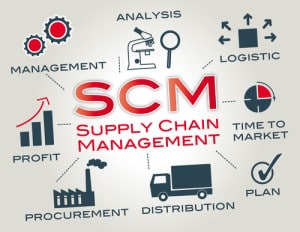
Managing today’s complex modern supply chains requires a digital nervous system based on robust data management, AI, and automation.
One of the lessons learned from the COVID crisis is that purchasing intentions can change overnight, and many of today’s existing supply chain systems may not be ready for such rapid shifts in purchasing patterns. Even the most intelligent companies with the most sophisticated analytics may not keep up without real-time data.
The challenge for today’s enterprises is that disruptions and interruptions in supply chains are not likely to let up anytime soon. To explore this challenge, we recently sat down with Mark Palmer, senior vice president of analytics at TIBCO Software; and Monica Cisneros, portfolio marketing manager at TIBCO; who discussed how, while modern supply chains are more complicated than ever before, the systems designed to manage them were built before IoT, before automation, and before real-time analytics were available to transform them. The solution, they urge, is to develop a “digital nervous system.” Here is a summary of our conversation.
Digitized supply chain management
RTInsights: Digitized supply chain management systems have been around for more than two decades. Where are the gaps that still require attention?
Palmer: The first gap is real time supply chain volatility. Resilient supply chains are more important than ever. Global warming and COVID-19 are the two most obvious forces for volatility at the moment.
However, most supply chains do not consider real-time data to address this gap. This failing creates supply chain systems that are flying blind in real-time.
The timing is good to fill this gap. The falling cost of sensors makes it easy to collect data from anything, everywhere. Weather feeds, satellites, drones, and connected vehicles provide this unique supply chain opportunity.
Real-time data from all these sources makes it possible to see and react to issues before they happen. Responsive supply chains are the result.
Advanced analytics & AI
RTInsights: What roles are advanced analytics and artificial intelligence (AI) playing in intelligent supply chains?
Cisneros: Recent AI, automation, and data management breakthroughs help supply chains of all types of sense and respond to real time conditions, just like your body’s nervous system. They can sense demand, operations, and volatile conditions and respond to what is happening now. We think of this technology fabric as the supply chain nervous system that provides operational excellence in real time.
The foundation of this supply chain nervous system is simplicity. Today, everything is connected, and every participant in a global supply chain must access data. Simply lowering the barrier between AI and human intelligence is what is needed. In addition, with open source at the core, and by democratizing business intelligence through self-service, an intelligent nervous system is now available to anyone.
The resulting connected intelligence enables a shift from reactive to proactive management for all parts of the supply chain. Digital twins allow us to predict future states, anticipate problems, model alternative scenarios, and choose an optimal solution. Humans can then better understand that digital fabric and act in real time.
Extending existing systems
RTInsights: How can existing supply chain management systems—especially those linked to ERP or enterprise financial systems—be extended to a digital supply chain nervous system?
Palmer: The basis of all supply chains is data. Two innovations make this nervous system work. The first is data virtualization. As the name implies, it virtualizes access to ERP and supply chain system-of-record data. Therefore, instead of duplicating it with ETL or a data lake, you leave it alone and access it as a single virtual store. Now, for the first time, TIBCO makes streaming data a first-class citizen in data virtualization: By connecting to TIBCO Data Virtualization, you can connect to 90 other real-time sources that impact the supply chain like weather, IoT sensor data, or drones.
The second innovation is all about metadata. Metadata describes and governs all your critical assets that define your supply chain. Breakthroughs in metadata management are making it simpler to create and maintain this supply chain DNA. For example, at Panera bread, it uses TIBCO EBX software to understand thousands of items that make up their menu, helping to improve the customer experience and their supply chain.
The race to become digital is just beginning. New tools are emerging that democratize access to a real-time view of the supply chain so anyone can see what is going on, like your body’s nervous system. So, if you want to go fast, go alone; if you want to go far, go together. That is, to innovate—to elevate—you must democratize real-time data and give everyone a view of what’s happening in real time.
Getting partners on board
RTInsights: The weakest link in supply chains may be partners with varying levels of technology—some of whom may even be still using legacy EDI systems or even paper-based documents. How can a company get them on board with a digital nervous system with more real-time streaming technology?
Cisneros: Implementing data virtualization may start small and grow with business needs. For example, a business may start with small data projects that have a time-to-solution focus and accept good-enough engineering, but then scale up to enterprise-scale standardized data services that ensure data consistency and engineering for scale.
As a business continues to grow, it can no longer rely on historical data analysis to inform its decisions. To understand and adapt to complex challenges as they occur, an organization must be prepared with streaming technology to adapt to new changes in the market.
For more information on TIBCO solutions, please visit https://www.tibco.com/solutions/supply-chain






